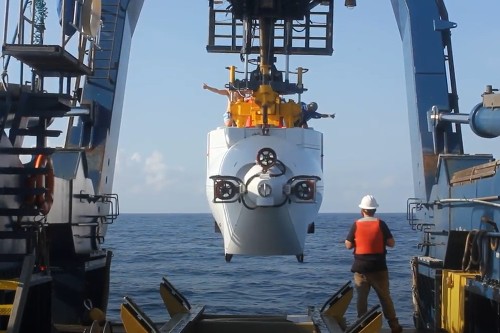Deep-sea Coral Reefs Discovered In Galápagos Expedition
Scientists from the University of Bristol are part of an expedition which has made a ground-breaking discovery of extensive, ancient deep-sea coral reefs within the Galápagos Marine Reserve (GMR).
This exciting discovery is the first of its kind to be documented inside the marine protected area (MPA) since the reserve was established in 1998.
The first reef observed was found at 400-600m (1,310-1,970 feet) depth at the summit of a previously unmapped area in the central part of the archipelago and supports a breathtaking mix of deep marine life.
Cresting over the ridge of a submerged volcano, and stretching over several kilometres, the reef structure was first recorded by Dr Michelle Taylor from the University of Essex and Dr Stuart Banks from the Charles Darwin Foundation while diving in the deep-sea research submersible Alvin,operated by the Woods Hole Oceanographic Institution (WHOI, USA).
The team have been carrying out a four-week expedition in the Galápagos Islands to monitor sea corals, lavas and the spectacular marine life surrounding them.
Dr Samuel Mitchell, a volcanologist from Bristol’s School of Earth Sciences, said: “On deep-sea expeditions of this kind, you can plan and plan, and still always be surprised by what you find. But sometimes you do just come across the unexpected.
“The first moments seeing the footage of this reef was met with gasps from the scientists onboard, and the wonder and excitement from the scientists who observed the reef in Alvin was palpable.
“We’ve used the submersible Alvin to dive on some amazing locations, all of which will help Bristol scientists better understand the history of the Galápagos Platform through analysing sampled deep-sea corals, but the discovery of this extensive reef will open up new science questions and directions for the coming years.”
Dr Mitchell, Professor of Geochemistry at Bristol, Laura Robinson, Research Associate Dr Qian Liu, and Bristol PhD students James Kershaw, Maoyu Wang, Yun-Ju Sun and Yingchu Shen are part of an international group of scientists undertaking the Galápagos Deep 2023 expedition.
Prior to the team’s discovery, Wellington Reef off the coast of Darwin Island in the far north of the archipelago was thought to be among the few structural shallow coral reefs in the Galápagos Islands to have survived the 1982-83 El Niño event. (El Niño is a climate pattern that describes the unusual warming pattern of surface waters in the Eastern Tropical Pacific Ocean).
The new discovery made during dives by scientists in Alvin shows that sheltered deep-water coral communities have likely persisted for centuries in the depths of the GMR, supporting rich, diverse, and potentially unique marine communities.
James Kershaw said: “By collecting water samples from near this reef, we can study the food supply and conditions which these corals need to survive. This helps us to understand the threats to these environments in the future.
Yingchu Shen added: “The live and fossil deep-sea corals collected can help us better understand the past and present East Equatorial Pacific, and benefit future ocean change projections and marine protection strategy. We look forward to welcoming the samples back to Bristol and see what stories of the ocean and climate they will tell us!”
Scientific findings such as this help inform effective management and conservation actions. The discovery also comes at a time when the Eastern Tropical Pacific countries of Panama, Costa Rica, Colombia, and Ecuador are actively collaborating through a regional Marine Corridor initiative to protect and responsibly manage the ocean. Natural oceanographic and marine processes transcend national boundaries, which underscores the need for special measures that protect foraging grounds, migratory routes for marine life and sustain responsible fisheries.
The expedition is led by scientists at WHOI, University of Bristol, Boise State University (USA), and University of Essex, in collaboration with the Galápagos National Park Directorate, Charles Darwin Foundation and Ecuadorian Navy’s Oceanographic and Antarctic Institute. The expedition is funded by the US National Science Foundation and Natural Environmental Research Council in the UK.

